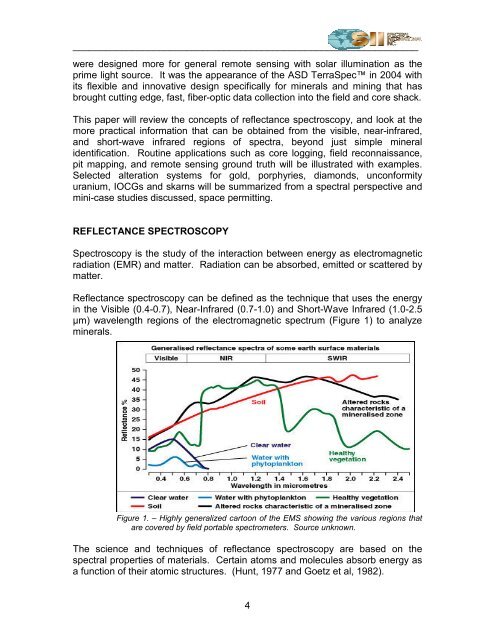An overview of vis-nir-swir field spectroscopy - Spectral International
An overview of vis-nir-swir field spectroscopy - Spectral International
An overview of vis-nir-swir field spectroscopy - Spectral International
You also want an ePaper? Increase the reach of your titles
YUMPU automatically turns print PDFs into web optimized ePapers that Google loves.
________________________________________________________________<br />
were designed more for general remote sensing with solar illumination as the<br />
prime light source. It was the appearance <strong>of</strong> the ASD TerraSpec in 2004 with<br />
its flexible and innovative design specifically for minerals and mining that has<br />
brought cutting edge, fast, fiber-optic data collection into the <strong>field</strong> and core shack.<br />
This paper will review the concepts <strong>of</strong> reflectance <strong>spectroscopy</strong>, and look at the<br />
more practical information that can be obtained from the <strong>vis</strong>ible, near-infrared,<br />
and short-wave infrared regions <strong>of</strong> spectra, beyond just simple mineral<br />
identification. Routine applications such as core logging, <strong>field</strong> reconnaissance,<br />
pit mapping, and remote sensing ground truth will be illustrated with examples.<br />
Selected alteration systems for gold, porphyries, diamonds, unconformity<br />
uranium, IOCGs and skarns will be summarized from a spectral perspective and<br />
mini-case studies discussed, space permitting.<br />
REFLECTANCE SPECTROSCOPY<br />
Spectroscopy is the study <strong>of</strong> the interaction between energy as electromagnetic<br />
radiation (EMR) and matter. Radiation can be absorbed, emitted or scattered by<br />
matter.<br />
Reflectance <strong>spectroscopy</strong> can be defined as the technique that uses the energy<br />
in the Visible (0.4-0.7), Near-Infrared (0.7-1.0) and Short-Wave Infrared (1.0-2.5<br />
µm) wavelength regions <strong>of</strong> the electromagnetic spectrum (Figure 1) to analyze<br />
minerals.<br />
Figure 1. – Highly generalized cartoon <strong>of</strong> the EMS showing the various regions that<br />
are covered by <strong>field</strong> portable spectrometers. Source unknown.<br />
The science and techniques <strong>of</strong> reflectance <strong>spectroscopy</strong> are based on the<br />
spectral properties <strong>of</strong> materials. Certain atoms and molecules absorb energy as<br />
a function <strong>of</strong> their atomic structures. (Hunt, 1977 and Goetz et al, 1982).<br />
4


